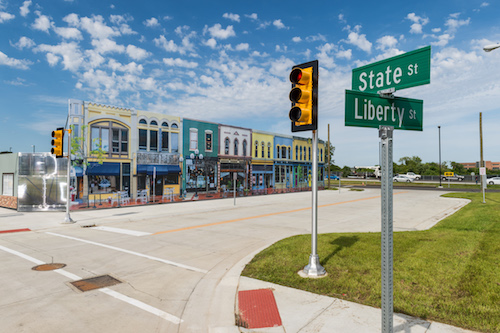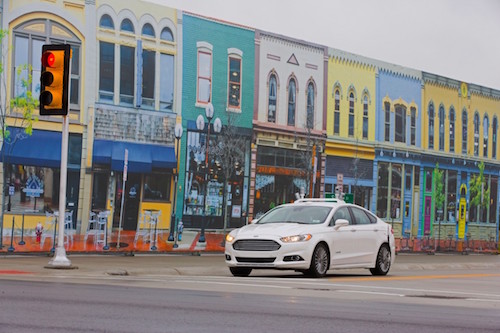Michigan, long the epicenter of America’s car industry, is aggressively jockeying to maintain its lead in the new era of autonomous vehicles by driving a variety of initiatives, including investment in major vehicle testing facilities.
Michigan, and specifically Ann Arbor, will be home to two permanent autonomous vehicle testing sites, the more prominent being Mcity, a 23-acre mini-city that opened last year as part of the University of Michigan’s Mobility Transformation Center. The second facility, the American Center for Mobility, will open in 2017 at the 335-acre former Willow Run factory in Ypsilanti Township and will feature long stretches of road where the autonomous cars can be tested at highways speeds and put through the paces of navigating complex intersections.
 Mcity mimics a full-scale urban environment for autonomous vehicle testing, including running a red light. Image Courtesy of the University of Michigan
Mcity mimics a full-scale urban environment for autonomous vehicle testing, including running a red light. Image Courtesy of the University of MichiganEarlier this month, Michigan Governor Rick Snyder underscored the state’s intent to dominate the autonomous and connected vehicle development landscape with a new campaign dubbed “Planet M.” The campaign is designed to align the state’s existing and emerging automotive assets and brain power around autonomous vehicle development, positioning it as a “hub of mobility innovation,” Snyder said in numerous statements.
With its deep roots in automotive product development, it makes perfect sense that Michigan try to grab the mantle for leadership in connected and autonomous vehicles — a market that Navigant Research predicts will reach 129 million vehicles sold between 2020 and 2035.
The University of Michigan’s Mcity test bed is one of the central pieces to helping the state stake claim to its goals. The facility, a safe, controlled environment to test connected automated vehicles, has been built with real-world conditions in mind: There are gravel roads; high-speed and low-speed on ramps reflecting both urban and suburban situations; pedestrian signs; and parking meters and parking spots. Even the road signs reflect real life, many not in mint condition as to explore the challenges facing image processing systems.
“This is not what you would normally think of as an automotive test track,” explained Jim Sayer, deployment director at Mcity, in a video about the simulated test facility. “It’s not about endurance or durability, it’s not high speed — it’s about dealing with complex real world scenarios that autonomous and automated vehicles have to contend with.”
Because most cities will not build autonomous vehicle infrastructure from scratch, but rather retrofit existing roadways, the Mcity test bed has also been designed to explore how the new cars operate in a legacy environment. The simulated city buildings are built with real-world materials like glass and vinyl so car makers can explore the impact of how the reflection of different surfaces affects operation. There is also heavy use of tree canopies lining the city streets to determine how their presence impacts the wireless communications between vehicles as well as from GPS signals.
“This is built to real-world standards,” said Sayer. “We need a closed, secure, repeatable environment and that’s what Mcity provides.”
 The Ford Fusion Hybrid Autonomous Research Vehicle, which merges driver-assist technologies like front-facing cameras and sensors, takes a spin at Mcity. Image Courtesy of Ford
The Ford Fusion Hybrid Autonomous Research Vehicle, which merges driver-assist technologies like front-facing cameras and sensors, takes a spin at Mcity. Image Courtesy of FordMcity is pretty tight-lipped about the test bed and the specific OEMs’ research efforts, but some of the companies have already announced their participation, including Ford, General Motors, Honda, Toyota and Nissan, as well as auto parts suppliers Bosch and Delphi. Toyota is also conducting other autonomous vehicle research in Ann Arbor, separate from Mcity. The company announced in April that it would put 5,000 connected cars on city streets as part of the Ann Arbor Connected Vehicle Test Environment (AACVTE) with the idea of collecting data using a small device installed in the trunk area of participating vehicles. The study is intended to develop research that will aid in the development of vehicle-to-vehicle and vehicle-to-infrastructure systems for self-driving cars.
Beyond Mcity, Google is testing autonomous vehicles on roads near its headquarters in Mountain View, CA, as well as in other testing facilities in Washington State and Texas.
Check out this video to get a tour of Mcity.
About the Author
Follow Robotics 24/7 on Linkedin
Article topics
Email Sign Up















